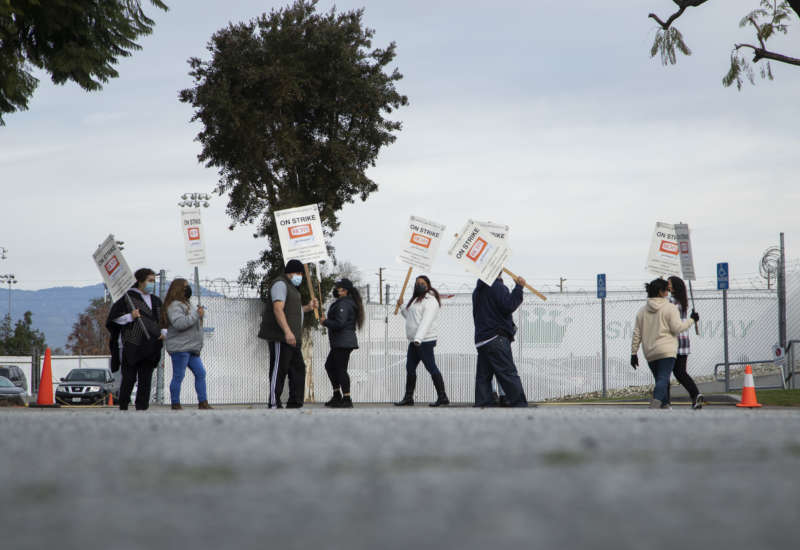On Thursday, the Bureau of Labor Statistics (BLS) released its latest report on inflation, and the news is not good for working people. According to the Consumer Price Index (CPI) — which measures the cost of consumer products — inflation for all goods, including food and energy, rose again in January, this time by 0.6 percent. This latest increase brings the yearly rate of inflation up to a whopping 7.5 percent, a figure not seen since the early 1980s when out-of-control inflation and a stagnant economy amounted to an all out economic war on U.S. workers. While wages for this same period have also gone up somewhat, rising between 4 and 4.4 percent, this is still far less than the current rate of inflation, and makes up for only a fraction of the value that workers’ wages have lost over the last several decades of neoliberal austerity.
Though unsurprising to anyone who has been paying attention, these latest figures exceeded the expectations of most bourgeois analysts who have been claiming for months that the current rate of inflation is a transitory phenomenon caused in large part by the pandemic, increased oil prices, increased demand, and weakened and overstressed global supply chains. While these factors have certainly contributed to rising costs, they are by no means the end of the story. In fact, large corporations have unsurprisingly used the inflation crisis to jack up the prices of many basic goods, even those unaffected by supply chain disruptions, far beyond what is needed to cover increased production costs, making record profits off the backs of workers and consumers in the process.
As economist Matt Stoller explained in December, increased profit seeking of major firms in the meatpacking, auto, and retail industries, among many others, is leading to a generalized increase in prices across the economy and could account for as much as 3 percent of the current yearly inflation rate. And indeed, corporate profit margins, despite inflation and the ups and downs of the pandemic, have soared over the last year, to levels not seen since 1950, far exceeding what they were earning before the pandemic. From Exxon Mobil, to Tyson, AstraZeneca, Amazon, and Starbucks, corporations are making a killing even as working people across the world struggle to maintain the value of their already low wages. While bourgeois economists like Stoller believe this problem can be controlled through anti-monopoly legislation or taxes on excess profits, such rapacious profit seeking and increasing exploitation of working people is endemic to capitalist production and can’t be legislated away.
Despite this corporate windfall, however, the Dow Jones Industrial Average fell almost 1.5 percent, and other indexes declined sharply on news of the report, largely over fears of a quicker and more virulent response by the Federal Reserve to the crisis. It appears that a full point increase in interest rates could come as early as this March, and many analysts are predicting that the Fed may raise interest rates by as much as 1.75 percent by the end of the year. Interest rates are currently near zero. While on the surface, interest rate hikes may seem to be of little concern for most working people who have few, if any, investments, they are designed to “cool the economy” by simultaneously discouraging spending and encouraging savings, and this can have serious consequences for working people. As we [Left Voice] explained last month:
Higher interest rates have a real effect on workers. They make it more expensive to spend money, and reduce disposable income. For the most marginalized people in society, they can render basic needs less accessible. And historically, higher interest rates have also kept U.S. companies from expanding employment.
And of course, interest rate hikes have historically been used as a cudgel to punish working people and undercut the power of unions. In the 1980s, for instance, the Reagan administration and Federal Reserve chair Paul Volker oversaw a policy of increasing interest rates that led to the loss of millions of manufacturing jobs and an unemployment rate above 10 percent.
Furthermore, increasing interest rates will almost certainly lead to further austerity, as cities and states face increasing borrowing costs to maintain or fund new investments in education, infrastructure, public housing, and services for the poor or homeless, many of whom are still suffering from the negative economic and health effects of the pandemic.
The ongoing inflation crisis, the cost of which is being passed entirely onto the working class, is just another example of the failure of a system that prioritizes chaotic production in the service of profit over a planned economy built around human need. For the ruling class, there is no solution to the crisis that does not involve further pain for working people, but this does not mean there is nothing to fight for. Using the methods of class struggle, strikes, and mass demonstrations, we can unite the working class to demand a bigger share of the value we produce, to resist austerity, to fight for automatic wage and benefit increases, and to demand a freeze on the price of vital goods and necessities paid for by the profits of the corporations that oversee their production. It is only in such struggles that we can discover and build our true strength as a class, one capable of directly vying for power and control over the productive forces of society.


